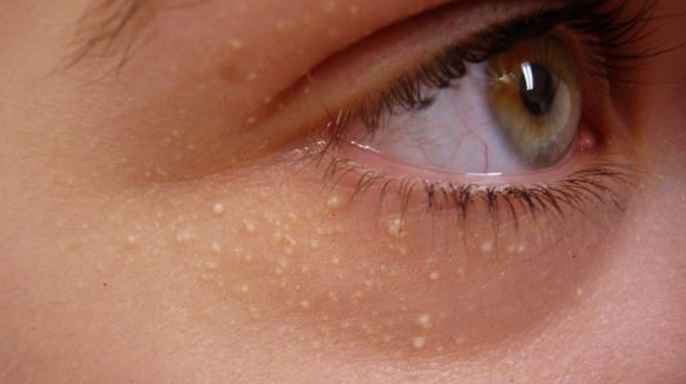When calcium phosphate is deposited in abnormal amounts in the soft tissue, calcinosis or calcification develops. Calcium deposits under the skin are white or yellowish lumps, often appearing in clusters. These calcium deposits also vary in size and quantity as well. When punctured, calcium deposits leak a white liquid, a paste like substance. Calcium deposits commonly appear in the elbows, shins or fingers, even though they can appear anywhere in the human body.

What Are the Symptoms of Calcium Deposits Under Skin?
Calcium deposits under the skin appear gradually without any signs or symptoms. However, signs and symptoms of an underlying medical condition that precipitates the onset of calcium deposits may become noticeable. Common symptoms of calcium deposits:
- There are white or yellow pimples or nodules on the skin.
- They are firm as calcium often forms hard masses.
- If these skin lesions ulcerate, a chalk-like discharge will be present.
- Tenderness and even pain on the affected area might be present.
- In cases of large calcium deposits near the joints, joint stiffness may occur, limiting significantly the joint mobility.
- Skin gangrene may develop at the affected area in severe cases of calcium deposits.
What Causes Calcium Deposits in Skin?
Based on the underlying cause, there are four different types of calcinosis:
Latrogenic Calcinosis Cutis
Iatrogenic calcinosis cutis develops from the use of certain medications and even undergoing certain medical procedures. Sometimes, iatrogenic calcinosis cutis resolves once these medications are discontinued. Common iatrogenic calcinosis cutis causes are:
- Injections of phosphate and calcium
- Prolonged use of electrode paste containing calcium
- Repeated heel sticks
Idiopathic Calcinosis Cutis
It occurs for unknown reasons, meaning that the real reason or factors that contribute to the development of calcium deposits under skin is not known. The levels of phosphate and calcium in the body are normal as well. Also, no previous tissue damage occurred which could lead to a collection of calcium under the skin. The patient diagnosed with idiopathic calcinosis cutis also does not take any medications nor has had any procedures recently which can contribute to the development of calcinosis.
Dystrophic Calcinosis Cutis
It occurs when the tissue got damaged, being the most common calcinosis. Usually, inflammation, tissue death or even malignancy, contribute to the collection of calcium deposits under the skin. Common dystrophic calcinosis cutis causes are:
- Trauma to the skin
- Skin infections
- Connective tissue diseases
- Panniculitis
- Varicose veins
- Acne
- Tumors
Metastatic Calcinosis Cutis
It is associated with excess phosphorus and calcium. Any medical condition or factor associated with hyperphosphatemia or hypercalcemia can easily lead to the development of this type of calcinosis. Common metastatic calcinosis cutis causes are:
- Kidney failure
- Sarcoidosis
- Paraneoplastic syndrome
- Hyperparathyroidism
- Milk-alkali syndrome
- Calciphylaxis
- Excess vitamin D
How to Treat Calcium Deposits on the Skin
Dealing with calcium deposits can be really annoying as they are often very hardly treated.
Medications
For this reason, you should consult your healthcare provider first. He/she might prescribe you medications such as steroids which will suppress the immune system. Other medications commonly recommended for the treatment of calcium deposits under skin include calcium channel blockers, aluminum antacids, diphosphonates, etc. Warfarin is also found to be effective especially in the very first stages of calcium deposits.
Often certain medical conditions or diseases are the ones behind calcium deposits under the skin. Managing these underlying medical conditions can help resolve your problem.
Laser Therapy
Laser therapy is often effective for the treatment of minor calcium deposits. Carbon dioxide laser therapy consists in using the energy of light which penetrates the skin, resolving calcinosis cutis partially or completely.
Another treatment option for calcinosis cutis is iontophoresis which consists in using low levels of electric current to deliver medications such as cortisone directly to the affected areas of the skin, dissolving this way the calcium deposits.
Surgery
In cases of large calcium deposits under the skin, their surgical removal might be necessary. Often, surgical treatment is necessary when these calcium deposits become painful, limit the range of motion of certain joints in the body or appear in clusters as well. However, you should keep in mind that surgical removal is not a permanent solution and that they can often reoccur.
Also, the surgical trauma itself can stimulate calcification, which can lead to even more calcium deposits under skin. Your healthcare provider will probably recommend a surgical removal only when other treatment options have completely failed.
Surgical Debridement
Surgical debridement is another option, so you should consult your healthcare provider first for any concern that you might have. Surgical debridement consists in removing the tissue with scissors or scalpels, especially when calcinosis cutis is accompanied by painful fingertips. Enzymatic debridement is another option, which combines a surgical debridement and application of certain topical ointments to the affected area of the skin.
A negative side of these treatments is that they can’t prevent new calcium deposits from forming in the future. This is the reason that makes people seek treatments that will help remove calcium deposits from the skin and not prevent them from occurring in the first place.
Massage
Many have found very effective massaging the affected area with olive oil as well as with aloe vera topical gels or creams. They work by making the skin supple and soft. When applied regularly, the calcium deposits will disappear with time.
Right Diet
Lowering the calcium you take daily with your diet might help as well. For this reason, certain foods should be avoided such as dairy products or foods packed with vitamin A and vitamin E. Fruit juices containing fortified calcium should be avoided as well.
